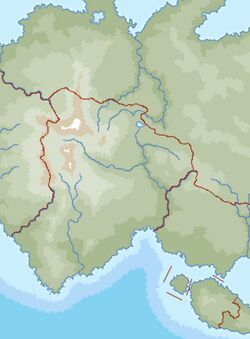Geography of Gotneska: Difference between revisions
Jump to navigation
Jump to search
No edit summary |
No edit summary |
||
| Line 1: | Line 1: | ||
{{Infobox country geography | {{Infobox country geography | ||
| name = Gotneska | | name = Gotneska | ||
| image name = | | image name = File:Geography of Gotneska.jpg | ||
| image size = | | image size = 250px | ||
| image caption = | | image caption = | ||
| image alt = | | image alt = | ||
| Line 21: | Line 21: | ||
| highest point = [[Skaðifjall]] 8,032 m (26,352 ft) | | highest point = [[Skaðifjall]] 8,032 m (26,352 ft) | ||
| lowest point = | | lowest point = | ||
| longest river = | | longest river = [[River Shannon]] 771 km (479 mi) | ||
| largest lake = | | largest lake = | ||
| climate = | | climate = | ||
Revision as of 02:21, 6 April 2022
 | |
| Continent | Argis |
|---|---|
| Borders | Aurivizh, Ulfheimr |
| Highest point | Skaðifjall 8,032 m (26,352 ft) |
| Longest river | River Shannon 771 km (479 mi) |
| Natural Resources | Gold, Silver, Trees, Water, Oil, Coal |
| Natural Hazards | tsunamis; volcanoes; earthquake activity around Geltic Sea, forest fires, permafost, flash floods, high winds. |
The geography of Gotneska is varied, from rural lowlands to unspoilt uplands, and from large cities to sparsely inhabited islands. Located in Southern Thrismari, Gotneska comprises the Southern half of the peninsula of [TBD] as well as 1100 surrounding islands encompassing the major archipelagos of the Cordic Isles, Isle of Blekinge and the Large and Small Fairly Islands.